Charles of the Ritz Powder Bars
In 1928, Charles of the Ritz launched a complete skin-care and make-up range. One of the features of the make-up range was individually blended powder and rouge. Clients coming to a Charles of the Ritz salon could have their complexion expertly analysed so that a shade of powder or rouge could be mixed to suit their particular colouring.
Individually blended powders
The idea of hand blending powders to suit individual clients was not invented by Charles of the Ritz. Most face powders in the 1920s came in a limited range of shades and, like nail polishes, women who could afford it, on both sides of the Atlantic, could have a face powder blended by an expert to suit their complexion.
Only a short time ago one of the bright, particular stars that beam on Broadway attracted attention by having a famous Parisian beauty specialist make a minute examination of her skin with a view to determining just what kind of face powder would be best suited to her complexion.
We all cannot have powders especially made for our own use, but we can blend our own special variety. The vogue of mixing your own powder, in addition to being fashionable, is sound common sense artistically. There are so many different types of complexion, so many subtle adjustments to color harmony in hair eyes, and skin, that it is really too much to expect that half a dozen shades of powder will furnish the perfect shade for every skin.
If, for instance, you like the basic tone of rachel, but feel the need of a little more color in your powder, you can add a tiny bit of Peaches and Cream powder, or even a faint flush of pink. If neither naturelle nor rachel seems to march your skin, you can combine the two shades—and perhaps the result will be the perfect shade for you.(Heloise, 1924)
The ever-increasing demand for complexion powders in the United Kingdom has brought Englishwomen a new career—that of powder chemist, and many women today make their living by blending and scenting toilet powders. These specialists find that it pays to have their own laboratories, so that they can make up special powders suit the needs of their clients.
At one such laboratory run by a woman it is now possible to obtain patterns of most fashionable colors, so that clients can get exactly the right shades for their complexions and their frocks. The patterns are sent out in attractive booklets of one leaf per shade, and when one considers that there are a t least 40 shades of powder ready for the summer season, the ease with which one could choose one “just the slightest fraction wrong” need not be emphasized.
(Woman powder blender makes debut in England, 1928)
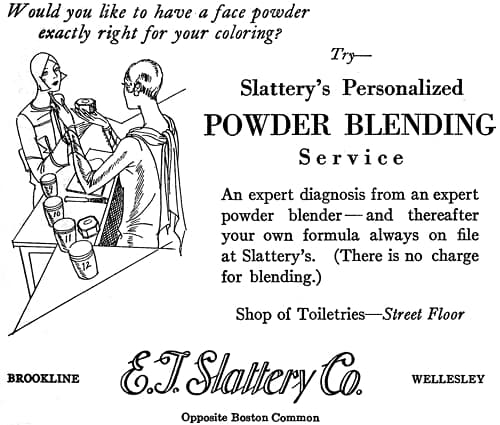
Above: 1928 E. T. Slattery Co. of Boston personalized Powder Blending Service.
As well as in-store powder blending services, some companies made kits that women could use to blend their own powder shades. The Luxor Powder Blending Kit included an aluminium Powder Blender, four Blending Powders and instructions on how to blend their own powders at home.
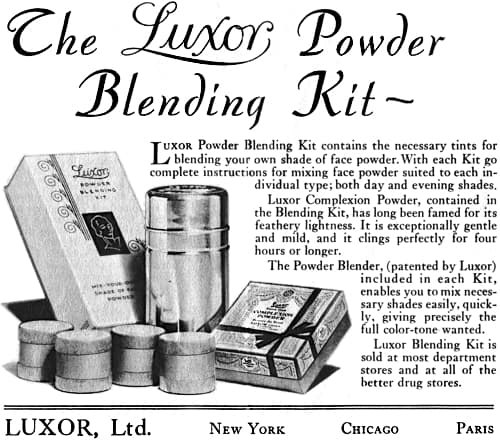
Above: Luxor Powder Blending Kit.
Also see the Luxor booklet: Now you can blend face powder to match your individual complexion (c.1930)
After Charles of the Ritz had success with his Powder Bars others copied the idea. In 1940, Jacqueline Cochran introduced Chromablend, a personalised service that blended individual foundation creams but then added Powderblend, a face powder blending service very similar to that offered by Charles of the Ritz.
See also: Jacqueline Cochran
Powder Bars
At first, Charles of the Ritz only offered the powder blending service through his salons but, by 1932 at the latest, he had begun setting up powder bars in department stores across the United States and elsewhere. These were staffed with ‘powder colorists’ who could mix a face powder to match the skin tone of any customer with the money to pay for it.
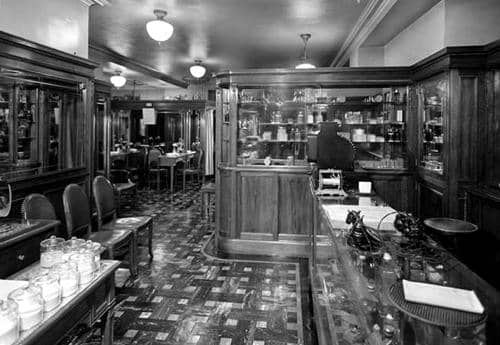
Above: 1932 Charles of the Ritz in the Ritz-Tower. Jars containing powders of various shades can be seen on the powder blending desk at the front left.
Doraldina, Inc. (Hollywood) offered a similar powder blending service but used a mechanical blender rather than doing it by hand.
Automatic Powder Blender
A machine for blending powder in three minutes. … The blender is intended for use in the toilet goods department for the blending of powder to individual customer’s needs and is offered as a means of stimulating sales.(From a note about Doraldina in AP&EOR, 1938)
Charles of the Ritz acquired the Doraldina Powder Blender technique when it purchased Doraldina in 1939 but does not appear to have used the machine.
Powder Blending Service
Charles of the Ritz made a number of claims for their individually blended powders.
1. Individually blended powder meets the challenge that no two women have exactly the same shade of skin. Your skin is as individual as your personality.
2. Individually blended powder enhances the naturally good values of your skin tones.
3. Individually blended powder, by subtle mixing, disguises any defects in your skin tones.
4. Individually blended powder enables you to wear many fashion colors which hitherto have been unbecoming by “toning up”—or “toning down” your complexion.
5. Individually blended powder, because it blends so perfectly with your natural color values, does not make constant re-powdering a tiresome necessity through the day.
6. Individually blended powder brings the effect of new life to your skin, for it complements rather than covers the natural beauty of your skin.
7. Individually blended powder gives you the same assurance of personalized beauty as does having a hat, a dress, a jewel made especially for your own personality.
8. Individually blended powder brings you the artistry used by great portrait painters in depicting skin tones which individualize each subject.
9. Individually blended powder is economical in that, because if belongs to you, and you alone, it does not go out of fashion.
10. Individually blended powder permits you to have your own formula altered as you wish it, by your Charles of the Ritz consultant, to meet seasonal changes in your complexion, without discarding a half-empty box.(Charles of the Ritz brochure, c.1941)
There were some changes to how the powders were blended over the years but the operation remained essentially the same until it disappeared in 1970s. Given the possible variations in skin tone, mixing the required shade on the spot required skill and training but Charles of the Ritz provided plenty of support on how best to do it.
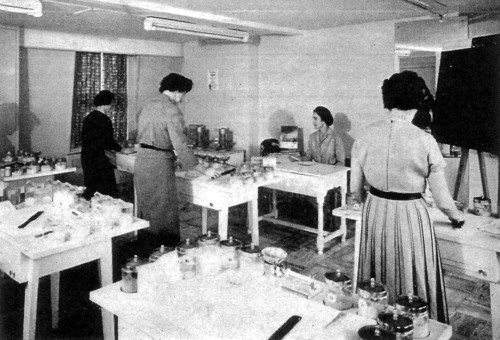
Above: Women training to operate a Charles of the Ritz powder bar in the U.K. in the 1960s.
Selecting colours
Charles of the Ritz supplied its powder blenders with 12 base shades of powder which were arranged around the mixing table, each marked with a one or two letter code representing the different shades: Rose Pink (RP), Apricot (AT), Light Brown (LB), Peach (P), Deep Phantasy (DP), Dark Brown (DB), Blush Pink (BP), White (WE), Rosewood (RW), Sepia (SA), Green (GN), and Opal (O).
The powder colorist would first select a base powder depending on the client’s colouring. Charles of the Ritz recommended that for fair skin this would be Rose Pink (RP); creamy fair skin, equal parts of Apricot (AT) and White (WE); light brunette or rachel skin, Apricot (AT); and dark brunette or for a sun-tan blend, Light Brown (LB). After selecting the base powder, she would then build the remainder of the formula in accordance with the client’s preferences – whether it was to match her complexion or to be lighter or darker – and to complement the type and colour of the foundation she was using. Different formulations could also be made up for day and evening wear, altered seasonally to allow for changes in skin colour or mixed to suit current fashion colours. A powder colorist could also adjust the colour of an existing powder if the skin colour of the client changed, as for example, if they acquired a tan.
To help with this process, Charles of the Ritz provided the powder colorists with suggestions for shade combinations for different powders.
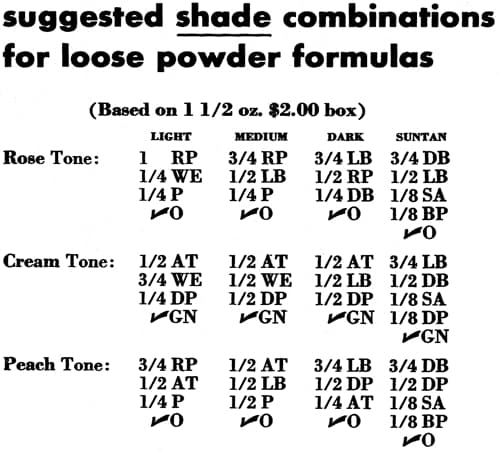
Above: Suggested shade combinations.
Powder colorists were also supplied with tips on how to make adjustments to these set combinations. For example, Opal (O) would ‘pick up the pink in a blend’, while Light Brown (LB) would ‘darken the shade slightly and give a soft pink glow’.
Measuring
A complication when selecting and mixing the powders was that their combined weight had to match the box selected to be filled – 1½ oz. for the $2.00 box; 3 oz. for the $3.00 box; and 5 oz. for the $5.00 box. Powder colorists used a set of scales to measure out the amount of each colour so that their combined weight was appropriate for the selected powder box size. Originally, double-pan balances were used but these were later replaced with single-pan models which removed the need for weights.
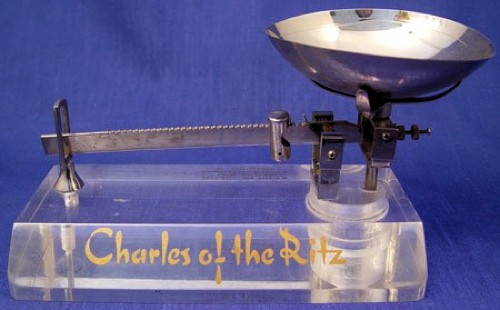
Above: A single-pan beam balance with a base made of lucite which replaced the earlier double-pan models. Each notch on the scale represented 1/16th of an ounce.
Mixing
Mixing the powder to avoid streaking required skill. It was done on a piece of clean paper where repeated heaping, subdividing and spreading blended the powder together. This might not mix the powder as well as a mechanical blender but in skilled hands the result would be good.
Above: 1958 Charles of the Ritz Face Powder Bar (British Pathé). The beauty specialist is Mary Sanders and the fashion model is Isabelle Babianska. Note the shade codes on the backs of the jars.
Client cards
Once a colour had been determined it would be entered on a client card so that further batches could be made up quickly when the client returned for a refill or requested further batches by post. Other information – such as recommended colours for rouge and lipstick – were also noted.
See also: Charles of the Ritz Sales Manual – Made to Order Face Powder (c.1961)
Powder press
In 1956, presses were introduced into the powder bars enabling the made-to-order powder to be compressed into a compact. The press used a hydraulic hand pump to compress the powder and had a gauge at the top to let the operator know when enough pressure had been generated to avoid cracking the cake. The resulting thin wafer was placed into a Charles of the Ritz compact and a puff added before it was handed to the client.
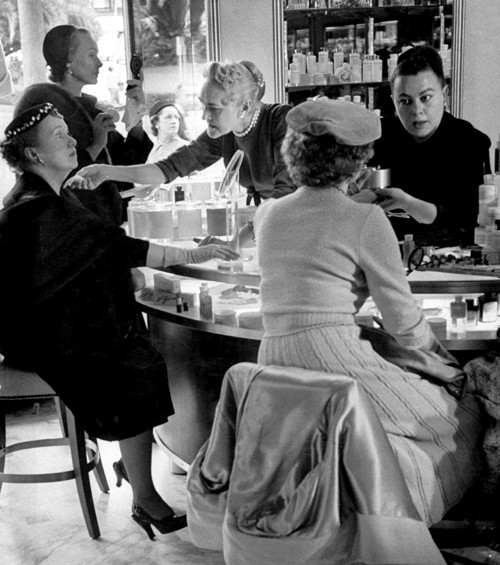
Above: 1956 Charles of the Ritz powder bar in San Francisco. The blending expert on the left is checking a powder match. She is working in ideal conditions for this due to the ample sunlight streaming in from the window to her right. The other consultant is using a powder press, only partly visible, to make up a compact while giving instructions, answering questions or making further sales. At the back a woman is viewing the effect of her made-to-order powder in the mirror of her compact (LIFE).
A set of equipment associated with a Charles of the Ritz powder bar that came up for sale included two metal cylinders along with the usual jars, scales and press. It is possible that these were used for additional mixing of the powder before it was placed in the press as they seem to be about the same diameter as a compact; however, this is just speculation.
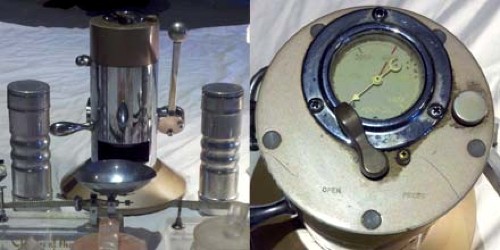
Above: Two images from set of Charles of the Ritz Powder Bar equipment. Left: The cylinders to the left and right of the press suggest that they have been used to further mix the powder or to settle it in the pan before it was compressed. Right: A close-up of the top of the press showing the pressure gauge and the open and close switch.
Gift boxes
Charles of the Ritz leveraged the idea of the powder bar by running advertising campaigns to sell empty, gift-wrapped powder boxes. The recipient would take the box to their nearest Charles of the Ritz powder bar to be filled with a custom-blended powder. Advertisements for these boxes were often aimed at men – particularly at Christmas – as they could buy the box without knowing what powder shade their wife or girlfriend used.
Worry about sizes, colors, styles? Not me! For Xmas I give her an empty powder box by Charles of the Ritz. What a cinch! No shopping to do … no worrying whether she’ll like it. She’ll love it! Especially the way the Ritz expert studies her … fusses over her … fills the empty gift powder box (she brings back) with her own face powder made-to-order right before her eyes exclusively for her—from me!
(Charles of the Ritz advertisement, 1947)
As well as making it easier for a man to buy a cosmetic for his wife or girlfriend, the tactic also brought new customers to the Charles of the Ritz counter and established a personal contact with them through the initial interview. This created an opportunity to establish a long and profitable relationship with a new client, a useful tactic in the competitive space of the department store.
See also: Charles of the Ritz
First Posted: 29th August 2011
Last Update: 31st May 2021
Sources
The American perfumer & essential oil review. (1939). New York: Robbins Perfumer Co.
Charles of the Ritz. (1932). Beauty in the modern mode [Booklet]. New York: Author.
Charles of the Ritz. (c.1939). Beauty in the modern mode [Booklet]. London: Author.
Charles of the Ritz. (c.1941). Personalized beauty care.[Pamplets]. New York: Author.
Charles of the Ritz sales manual. (c.1961).
Heloise. (1924). “Mixing your own” as applied to face powder in order to have the exact shade. The Brooklyn Standard Union, Sunday, September 7th, 2.
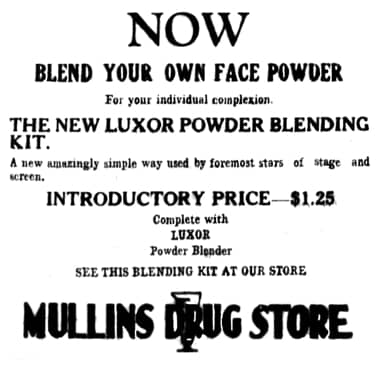
1930 Luxor Powder Blending Kit.
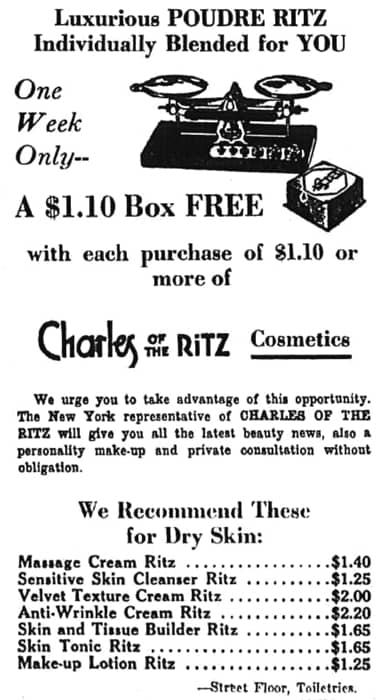
1933 Charles of the Ritz individually blended Poudre Ritz showing the box used to hold the finished powder and the double balance used to measure out the individual colours.
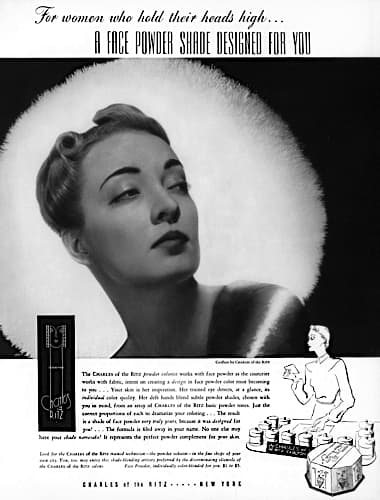
1938 Charles of the Ritz individually coloured face powder at the Ritz Carlton.
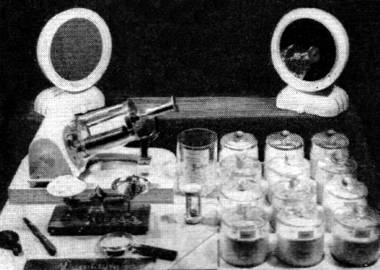
1939 Doraldina Powder Blender using twelve powder bases. There seems to be a mechanical mixer in the photograph which does not appear to have been used in Charles of the Ritz powder bars.
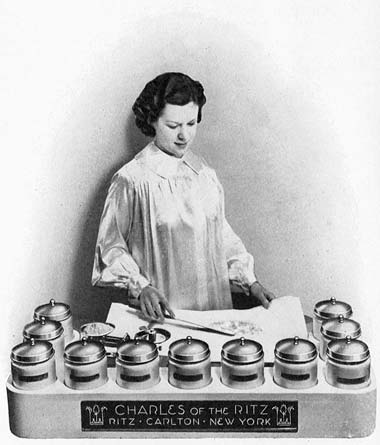
c.1939 An English Charles of the Ritz powder bar. Note the two-pan beam balance, the large spatula for blending and the clean sheet of paper. Only eleven powders bases are depicted in this photograph rather than the usual twelve.
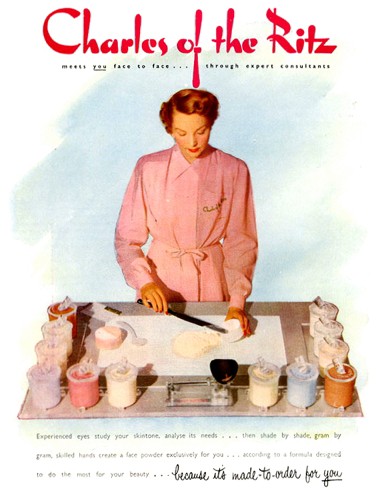
An English Charles of the Ritz powder bar. The powder colorist is filling a powder box, the lid of which can be seen to her right.
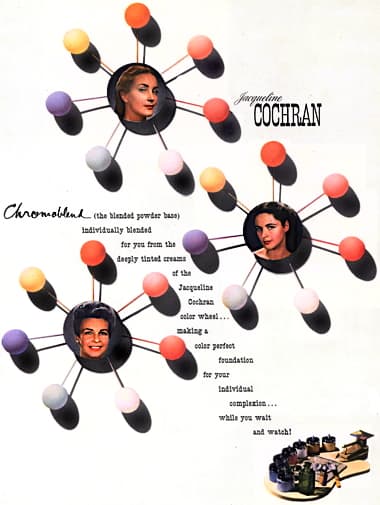
1944 Jacqueline Cochran Chromablend, the forerunner of her Powderblend service.
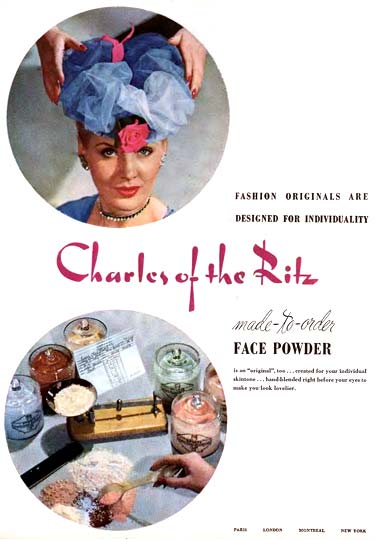
1945 Charles of the Ritz made-to-order face powder. Note the single-pan beam balance. The wooden base was later replaced with one made of lucite. A client card is also visible with the client’s details and powder formula entered.
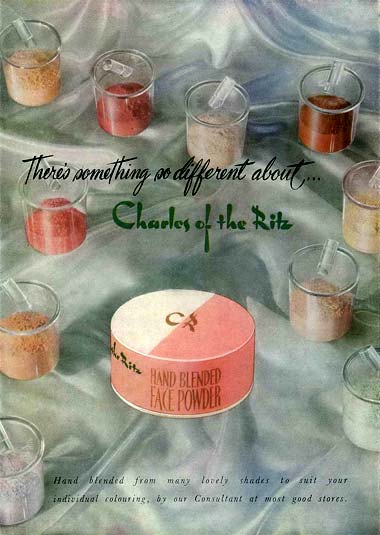
1948 Charles of the Ritz hand blended face powder box and ten of the twelve powder bases used.
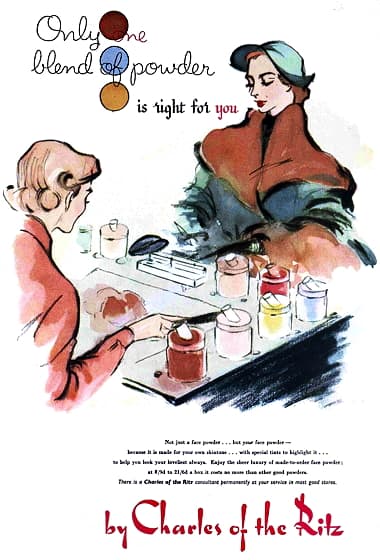
1954 Charles of the Ritz powder bar (Britain).
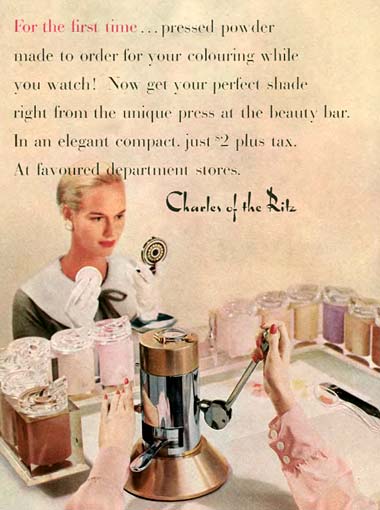
1956 Charles of the Ritz powder press used to compress the made-to-order powder into a compact.
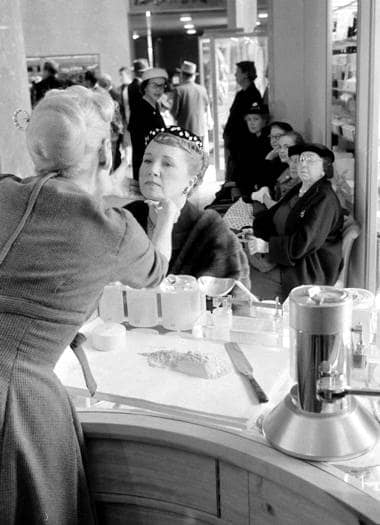
Above: 1956 Charles of the Ritz powder bar in San Francisco. The powder colorist is checking a powder match on the client before she packs the powder into a box or compresses it. You can just make out a two letter code on the base of each jar of powder (LIFE).
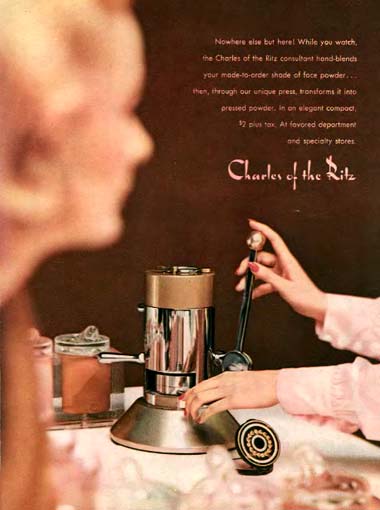
1957 Charles of the Ritz powder press and compact.
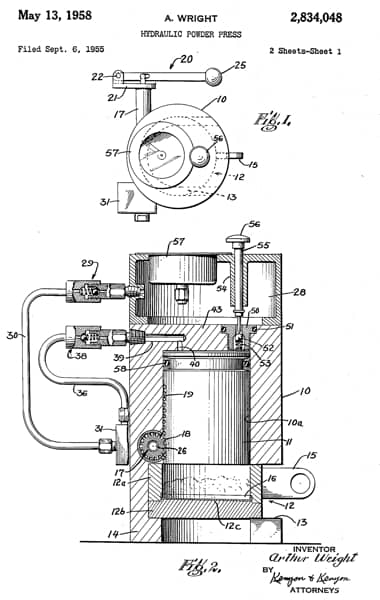
1958 Drawings from the patent granted to Charles of the Ritz for a powder press (US2834048, 1958).
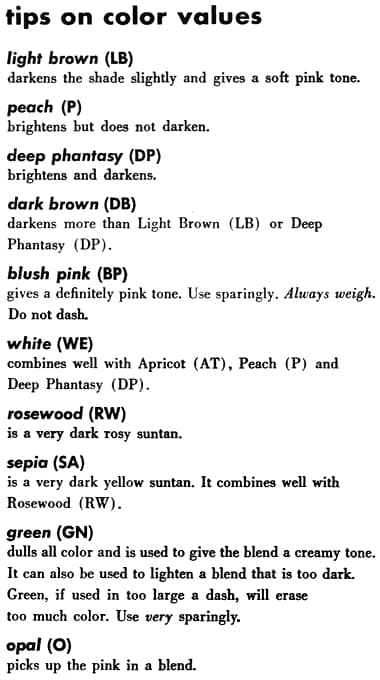
c.1961 Charles of the Ritz tips on color values.
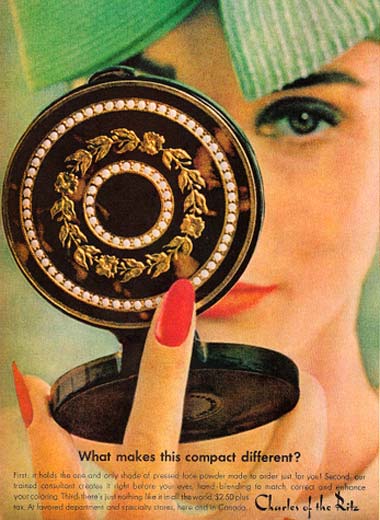
1962 Charles of the Ritz compact.
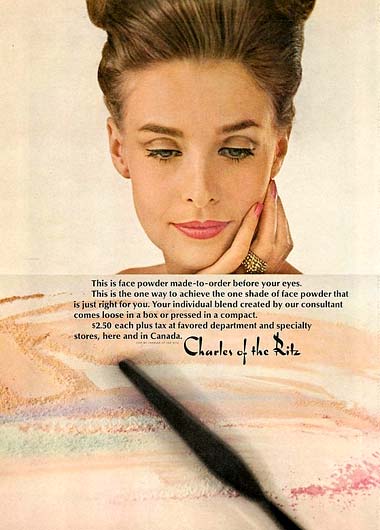
1963 Charles of the Ritz made-to-order powder. The flat part of the spatula was used to blend the powder after its edge was first used to heap and then break it up. Repeating the process would ensure a good mix.
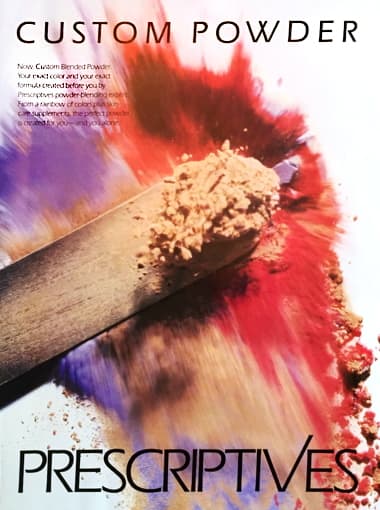
1988 Prescriptives. A later attempt to revive individual powder blending.
